Sarah Sundin's Blog, page 173
March 16, 2020
Giveaway Winners!

Christian Fiction Scavenger Hunt
Thank you to everyone who joined us for the Christian Fiction Scavenger Hunt! The names of the five winners for the main scavenger hunt are posted on Lisa Tawn Bergren‘s site. If you missed my article on “Books in World War II,” it’s still on my blog.
The winner of the individual giveaway of The Land Beneath Us on my post is…
Vickie Watts!
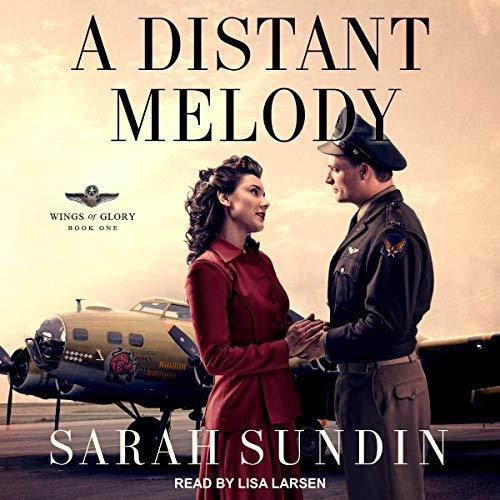
A Distant Melody Audio Book Giveaway
Also, thank you to everyone who entered the giveaway celebrating the audio book release of my first novel, A Distant Melody – and celebrating that novel’s 10th birthday! You can still read the articles about the B-17 Flying Fortress, the B-17 crew, and about my ride in a B-17 (with video)! The winners of the audio book codes of A Distant Melody are…
Michele Farley
Deborah Cooney
All winners have been notified by email.
Thanks again!
March 15, 2020
Today in World War II History—March 15, 1940 & 1945

Advertisement about penicillin from Schenley Laboratories, 14 August 1944
80 Years Ago—March 15, 1940: Movie premiere of Young Tom Edison, starring Mickey Rooney.
Movie premiere of comedy My Little Chickadee, starring Mae West and W.C. Fields.
75 Years Ago—March 15, 1945: Canadian I Corps enters service in northern Europe after transfer from Italy.
Academy Awards:
Best movie of 1944—Going My Way
Best actor—Bing Crosby in Going My Way
Best actress—Ingrid Bergman in Gaslight
Best director—Leo McCarey for Going My Way.
US War Production Board makes penicillin available for civilian use.
March 11, 2020
Christian Fiction Scavenger Hunt Stop #10

Welcome to the Christian Fiction Scavenger Hunt! If you’ve just discovered the hunt, be sure to start at Stop #1, and collect the clues through all the stops, in order, so you can enter to win one of our top 5 grand prizes!
THIS HUNT IS NOT YET LIVE. WE’RE STILL WORKING OUT OUR LINKS. WE GO LIVE AT 11 AM PST on 3/12. PLEASE RETURN AFTER THAT!
The hunt BEGINS on 3/12 at 11 am PST/ 2 pm EST with Stop #1 at LisaTawnBergren.com .
Hunt through our loop using Chrome or Firefox as your browser (not Explorer).
There is NO RUSH to complete the hunt—you have all weekend (until Sunday, 3/15 at 11 pm PST/midnight MST)! So take your time, reading the unique posts along the way. Our hope is that you discover new authors and new books and learn new things about them.
Submit your entry for the grand prizes by collecting the CLUE on each author’s scavenger hunt post and submitting your answer in the Rafflecopter form at the final stop, back on Lisa’s site . Many authors are offering additional prizes along the way (including me! See below)!
 I’m Sarah Sundin, and I enjoy writing about the drama, daring, and romance of the World War II era. You can learn more about me and my books here on my site and on Facebook, Twitter, Pinterest, and Instagram. My latest release is The Land Beneath Us:
I’m Sarah Sundin, and I enjoy writing about the drama, daring, and romance of the World War II era. You can learn more about me and my books here on my site and on Facebook, Twitter, Pinterest, and Instagram. My latest release is The Land Beneath Us:
With his future stolen by his brothers’ betrayal, Private Clay Paxton trains hard with the US Army Rangers, determined to do his best in the upcoming Allied invasion of France. Leah Jones works as a librarian at the army base, hoping to find her lost sisters. A marriage of convenience binds them together, but will D-day—and a foreboding dream—tear them apart?
To go along with Leah’s librarian bookishness…
Books in World War II

“Soldiers at Camp Robinson, Arkansas, trying to get books from the Service Club Library. Although the library has 5000 books, it is badly in need of more. The average circulation runs about 200 to 300 books per day, with a record of 525 in one day. Miss Maurine Doores is the librarian.” January 22, 1942. (Signal Corps Photo #162-42-79 by Weber, 162nd Signal Photographic Company.)
When the United States entered World War II in 1941, the average American soldier had an eleventh-grade education and didn’t read for pleasure. Hardback books cost $2, expensive considering the average yearly wages of about $2000.
Pocket Books had begun publishing the first mass market paperback books in the United States in July 1939 for only 25¢, but as of 1939, under 200,000 paperbacks were published each year.
Book Burnings
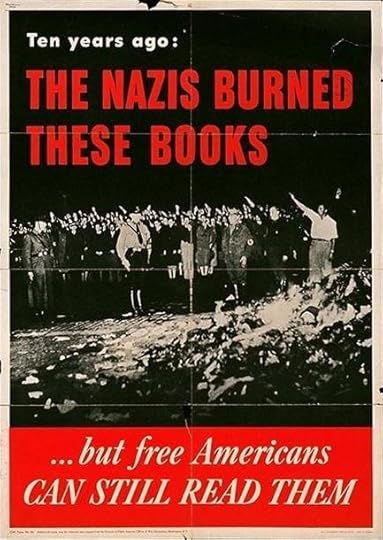
US poster, 1943
When the Nazis came to power in Germany in 1933, massive book burnings were held, destroying millions of books by authors who were Jewish, who spoke out against the Nazis, or who had opposing political ideas. And as the Nazis conquered other countries, they burned and confiscated books as well. In all, the Nazis are believed to have destroyed 100 million books.
This censorship and destruction struck deep at the heart of those in the western democracies and reminded them that books and ideas were vital to freedom.
Servicemen Need Books
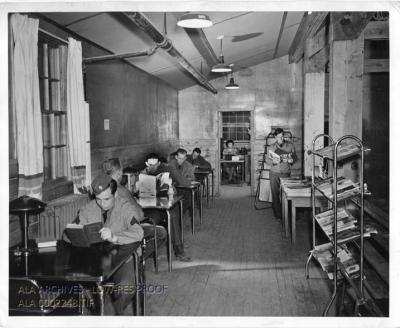
Soldiers Reading at Camp Forrest Library, Tullahoma, TN, 13 Feb 1942 (US Army Signal Corps)
Boredom kills morale, so the US armed forces provided libraries at training camps and bases. Servicemen were often too exhausted from a day of training to engage in sports, so many frequented the libraries and discovered the joy of a good book.
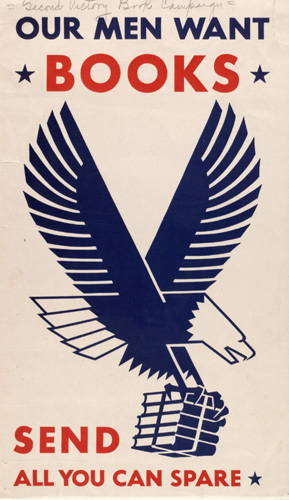
Poster from the US Victory Book Campaign, 1942-43
The US Army wanted to have one book per enlisted man. But when the US instituted the peacetime draft in 1940, men flooded the training camps – and their libraries. Local communities held drives to supply the libraries, but it wasn’t enough.
Victory Book Campaign
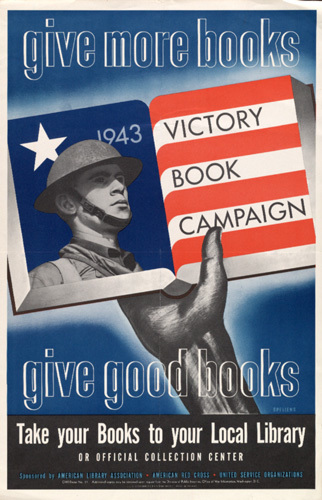
Poster for the US Victory Book Campaign, 1943
Responding to this need, the American Library Association, working with the USO and the American Red Cross, founded the National Defense Book Campaign in November 1941. The following month, after Pearl Harbor, the name was changed to the Victory Book Campaign.

American Red Cross volunteers collect books for the Victory Book Campaign in World War II (US Army Center of Military History)
The first book drive started January 12, 1942. Throughout the nation, people were urged to donate used books for the soldiers. Various groups collected the books, including the Red Cross, Boy Scouts, and Girl Scouts. Local libraries sorted the books, which were then sent to Army and Navy camps.
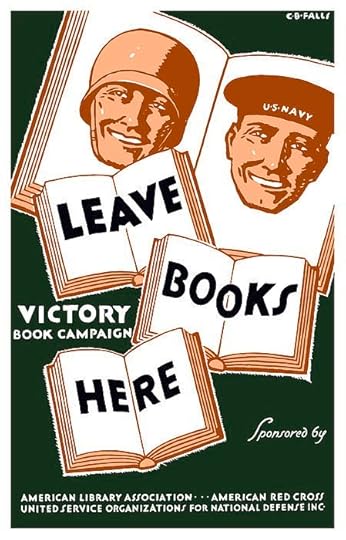
Poster for the US Victory Book Campaign, 1942-43
While well intentioned, the program had some problems. First, about one-third of the donated books were unusable—worn-out books, children’s books, or titles of little interest to young men. Second, the typical hardback book was heavy and large. Shipping was expensive and used valuable cargo space needed for war materiel, and the books were too unwieldy for the men to carry into combat. Third, by 1943, donations dropped as the supply of excess books decreased.
In May 1943, the Army and Navy declared Victory Book Campaign books were no longer needed, and the program was shut down at the end of the year. Still, the campaign collected 18 million books, 11 million of which were distributed.
Armed Services Editions

Armed Services Edition of The Great Gatsby by F. Scott Fitzgerald, in Library of Congress Rare Books and Special Collections Division (Library of Congress, photo by Shawn Miller)
In March 1943, the Council on Books in Wartime was founded by 70 representatives of publishing houses. Working with the armed services, they came up with an ingenious—and generous—plan.
Publishers allowed their books to be published in special Armed Services Editions, accepting only 1¢ royalty per volume, to be split between the publisher and the author.
The Armed Services Editions were printed on thin paper with small font, in a size small enough to fit into a uniform trouser pocket. These thin paperbacks were designed to be passed around between servicemen and eventually discarded.

Armed Services Edition of The Story of George Gershwin by David Ewen, in Library of Congress Rare Books and Special Collections Division (Library of Congress, photo by Shawn Miller)
The Council chose titles in a variety of genres—“dime store” cowboy and detective novels, high literature, history, biography, poetry, humor, and more. The concept was to entertain and to educate, and the Council did not shy away from controversial titles—although they did not publish any that might give “comfort to the enemy.”
Starting in September 1943, thirty Armed Service Edition titles were published each month, with 50,000 copies of each title. Both the quantity of titles and the print runs increased during the war due to high demand.
An Army of Readers

Servicemen bound for Guadalcanal grab books as they board. (U.S. Navy)
Men carried the Armed Services Editions into battle, from Omaha Beach to Iwo Jima to Okinawa. They read them to their buddies in their ship’s hammocks. They read by the light of artillery shells at night.
The men found books inspired them, reminding them of why they fought. Books distracted them from the horrors and rigors and boredom of military life. And books taught them new things and opened new doors and windows.
By the time the Armed Services Editions program ended in 1947, 123 million books had been published.
A Nation of Readers
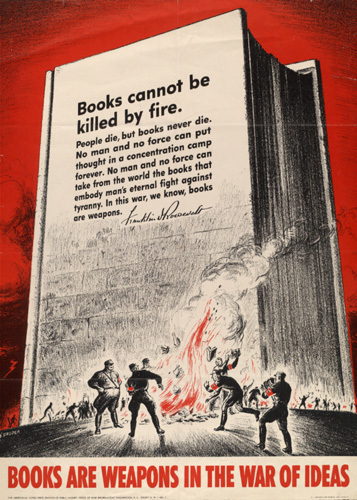
US poster, WWII
There was a severe paper shortage in the US from 1943-45 – the publishing industry was restricted to 37.5% of the paper they’d used in 1939. Even so, the number of books published actually increased during the war due to the rise of paperbacks. By 1943, over 40 million paperbacks were being published a year!
With the Victory Book Campaign and the Armed Services Editions and the inexpensive paperbacks, a new generation of readers had been created. Servicemen who’d never considered themselves readers had found that they could read history and poetry—and like it. Books were no longer only for the rich, but for everyone, democracy in action.
After the war, many of the soldiers and sailors and airmen went to college on the GI Bill, inspired and encouraged by the books they’d read—and by realizing they did in fact enjoy reading.
The motto “Books are weapons in the war of ideas” was proven correct. In the end, generosity and freedom triumphed over destruction and censorship, and the whole world benefited.
(For resources, scroll to the bottom of the post)
Stop #10 Basics:
You can order The Land Beneath Us on Amazon, Barnes & Noble, ChristianBook, or at your local bookstore!
Clue to Write Down: But a
Link to Stop #11, the Next Stop on the Loop: Susan Sleeman’s site!
But wait! Before you go, I’m offering an additional book giveaway! Winner’s choice of paperback or CD audio book of The Land Beneath Us! All you have to do is sign up for my email newsletter (top right corner of this page) or be a current subscriber. (US mailing addresses only please). Enter via the Rafflecopter below. The winner will be announced on March 16, 2020.
Resources:
Manning, Molly Guptill. When Books Went to War. New York: Mariner Books, 2014.
Appelbaum, Yoni. “Publishers Gave Away 122,951,031 Books During World War II.” The Atlantic, 10 September 1941. Accessed 5 March 2020.
Allen, Erin. “Books in Action: The Armed Services Editions.” Library of Congress blog, 30 September 2015. Accessed 5 March 2020.
Brozyna, Andrew. “The Victory Book Campaign.” On the Books for Victory website, 11 June 2012. Accessed 12 June 2012. (Site no longer active).
The B-17 Flying Fortress, Part 2 – Crew

B-17G Aluminum Overcast owned by the Experimental Aircraft Association, Buchanan Field, Concord, CA, 2 May 2011 (Photo: Sarah Sundin)
 Few World War II airplanes have captured the imagination like the Boeing B-17 Flying Fortress. I’ve enjoyed walking through many of these planes, and in 2011 I had the awesome privilege of flying in the Experimental Aircraft Association‘s Aluminum Overcast. You can read about my flight and watch a video here.
Few World War II airplanes have captured the imagination like the Boeing B-17 Flying Fortress. I’ve enjoyed walking through many of these planes, and in 2011 I had the awesome privilege of flying in the Experimental Aircraft Association‘s Aluminum Overcast. You can read about my flight and watch a video here.
To celebrate the brand-new audio book version of my debut novel, A Distant Melody (Revell Books, 2010), I’ll feature the legendary Flying Fortress – a starring side character in the Wings of Glory series. Yesterday I talked about the plane and today I’ll discuss the crew.
**GIVEAWAY** For a chance to win one of two audio book codes for A Distant Melody, please leave a comment below. You can earn two entries by commenting on both posts (B-17 Flying Fortress and B-17 Crew). Giveaway ends Sunday, March 15, 2020 at 10 pm Pacific Time. I’ll announce the winners on my blog on Monday, March 16, 2020.
Crew Loyalty
Both the B-17 Flying Fortress and the B-24 Liberator were used by the United States Army Air Force as long-rage, high-altitude, four-engine heavy bombers. A friendly rivalry grew between crews of the “Fort” and the “Lib.” On paper, the B-24 seems to be the winner, with a higher speed, larger bomb load, and longer range. But fans of the B-17 not only liked its graceful lines and the ability to fly at higher altitudes, but its ruggedness. While the B-24 had a tendency to break up when ditching at sea, the B-17 was more likely to stay intact, and the survival rate from ditching was far higher in the B-17.
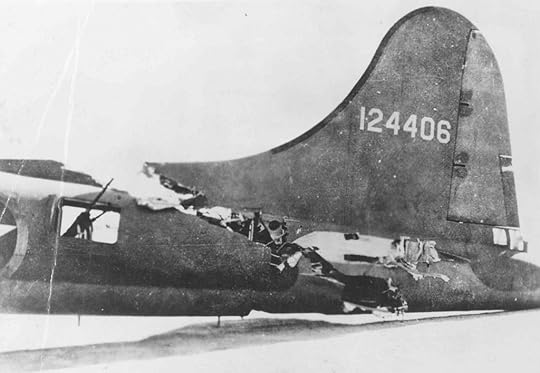
All-American, a B-17F almost severed in half by a collision over Tunisia. The pilot compensated for the lost and damaged controls and brought the plane home. Miraculously, even the tail gunner survived. (US Air Force photo)
The Flying Fortress could take lots of damage and still get the crew home. The photo above shows the All-American, a B-17F almost severed in half by a collision over Tunisia. The pilot compensated for the lost and damaged controls and brought the plane home. Miraculously, even the tail gunner survived. Numerous stories like this brought fierce loyalty from B-17 crews.
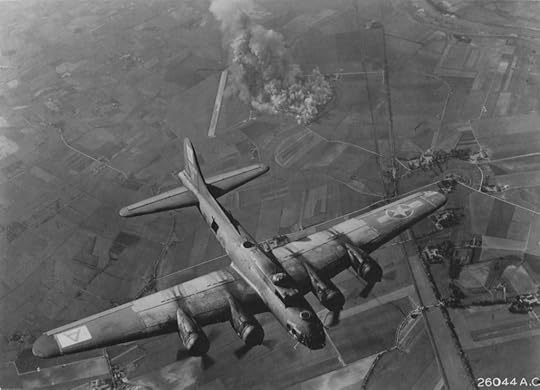
B-17F of US 94th Bomb Group over Marienburg, Germany, 9 October 1943 (US National Archives)
Over time, the B-24 became favored in the Pacific for its range and bomb load, while the B-17 became the heavy bomber of choice in the European Theater.
The Crew in the Cockpit

Cutaway diagram of a B-17G Flying Fortress (Sarah Sundin)
This cutaway view of a B-17G shows the positions of the ten crew members.
The pilot and copilot sat at position #1 in the cockpit. Both started as lieutenants. The pilot also served as crew commander, in charge of discipline and morale. The copilot assisted the pilot in flying the plane and could take control if the pilot was disabled. During a mission, the copilot took responsibility for interphone communications with the rest of the crew.
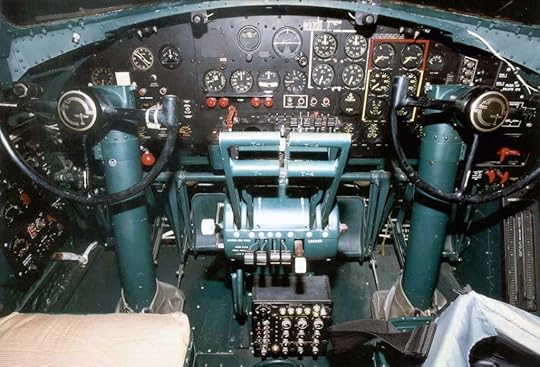
Boeing B-17G Flying Fortress cockpit at the National Museum of the U.S. Air Force. (U.S. Air Force photo)
Just behind the pilots stood the flight engineer/top turret gunner (position #4). A technical sergeant, this man knew the plane’s operating systems extremely well and took responsibility for repairs in flight. In combat he operated the top turret gun.
Crew in the Nose Compartment

Close-up view of nose of Collings Foundation B-17G Nine-O-Nine, Buchanan Field, Concord, CA, June 2013 (Photo: Sarah Sundin)
The nose compartment was separated from the cockpit by a narrow crawlway. The navigator, a lieutenant, sat at a desk at position #3, where he carefully charted the plane’s position and course using dead reckoning, pilotage, radio aids, and even celestial navigation. Although B-17s flew in large formations, each plane had to be able to find its way to the target and home if separated from the group. In combat, the navigator was responsible for the left cheek gun (in the B-17F) and for both cheek guns in later models of the B-17F and in the B-17G.
The bombardier also served in the nose compartment (position #2). A lieutenant, the bombardier was responsible for loading the bombs on the ground, arming the bombs in flight, and most importantly, for accurately aiming and dropping the bombs. He operated the Norden bombsight, a complicated piece of machinery that took into account the plane’s speed, wind speed and direction, and drift to more precisely hit the target. Later in the war, fewer bombardiers were trained, and a “togglier” served in most planes. The togglier released the bomb on the signal of the lead aircraft in the formation but did not operate the Norden. The bombardier operated the right cheek gun in the B-17F, the nose gun in the later B-17F models, and the chin turret guns in the B-17G.
Crew in the Radio Compartment
Heading back from the cockpit, we walk through the bomb bay along a narrow aluminum catwalk. On either side, racks hold bombs on the way to the target.
Behind the bomb bay sits the radio compartment, home of the radio operator (position #5), a technical sergeant in charge of the multiple radio communication and navigation devices on board the plane. In some models, the radio room contained a machine gun, which fired out of the roof to the rear. However, vision was limited and most groups did without the extra weight of this gun.

Close-up view of Collings Foundation B-17G Nine-O-Nine, showing (L to R) the waist guns (center) and ball turret (below), open bomb bay doors, top turret. Buchanan Field, Concord, CA, June 2013 (Photo: Sarah Sundin)
Gunners in the Waist, Belly, and Tail
Four staff sergeants manned the guns in the ball or belly turret (position #6), to the left and right in the waist compartment (position #7), and in the tail turret (position #8). In addition to constantly watching for enemy fighter planes, these gunners also monitored the positions and condition of other planes in the formation. The ball turret was a cramped location, so the smallest crew member usually took this station.

My youngest son manning the waist gun in the Collings Foundation B-17G Nine-O-Nine, Buchanan Field, Concord, CA, June 2013 (Photo: Sarah Sundin)
If you ever have the opportunity to walk through a B-17 – or fly in one! – imagine ten men at their stations, all wearing heavy high-altitude flight gear, including parachutes, life vests, and flak vests. Then imagine them at -40 degrees with flak and fighters in all directions. You’ll gain a deep appreciation for what our veterans did for the sake of freedom.
March 10, 2020
The B-17 Flying Fortress, Part 1

B-17G Flying Fortress Shoo Shoo Baby of the 91st Bomb Group (USAF Museum)
 Few World War II airplanes have captured the imagination like the Boeing B-17 Flying Fortress. I’ve enjoyed walking through many of these planes, and in 2011 I had the awesome privilege of flying in the Experimental Aircraft Association‘s Aluminum Overcast. You can read about my flight and watch a video
here
.
Few World War II airplanes have captured the imagination like the Boeing B-17 Flying Fortress. I’ve enjoyed walking through many of these planes, and in 2011 I had the awesome privilege of flying in the Experimental Aircraft Association‘s Aluminum Overcast. You can read about my flight and watch a video
here
.To celebrate the brand-new audio book version of my debut novel, A Distant Melody (Revell Books, 2010), I’ll feature the legendary Flying Fortress – a starring side character in the Wings of Glory series. Today I’ll talk about the plane and tomorrow about the crew.
**GIVEAWAY** For a chance to win one of two audio book codes for A Distant Melody, please leave a comment below. I’ll announce the winners on my blog on Monday, March 16, 2020.
Development
In 1935, the US Army called for a multi-engine, long-range, high-altitude heavy bomber. On July 17, 1935, Boeing introduced Model 299, which made its maiden flight on July 28, exceeding Army specifications. With plenty of machine guns, it was dubbed the “Flying Fortress” by a reporter. Although Model 299 crashed on an early flight, Boeing received a contract to develop the YB-17 in 1936.
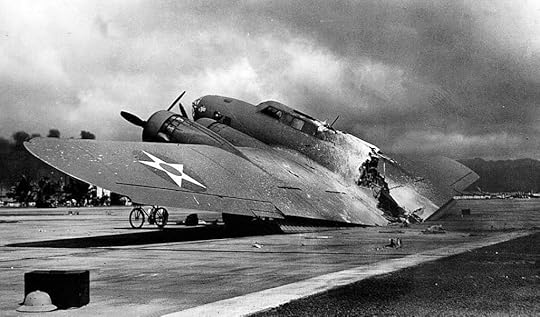
Wreck of B-17C bomber at Hickam Field, Territory of Hawaii, 7 Dec 1941 (US National Archives)
Improvements were made with each successive model – the B-17B in October 1939, the B-17C in July 1940, and the B-17D in February 1941. The C and D models were involved in America’s entry into World War II – shot up on the ground in Hawaii and the Philippines and flying early bombing missions. Since a squadron of twelve B-17Ds was expected in Pearl Harbor early on December 7, 1941, when radar showed the approaching Japanese planes, the officer in charge dismissed the warning. Read the story here.
Combat Models
The B-17E rolled out in September 1941, the first model to sport the distinctive bell-shaped vertical stabilizer (tail fin). This model was used in the Eighth Air Force’s first combat missions over Nazi-occupied Europe in late 1942. Further refinements led to the F model in August 1942. One of the most famous B-17Fs was the Memphis Belle, the first plane and crew to finish 25 missions in Europe.
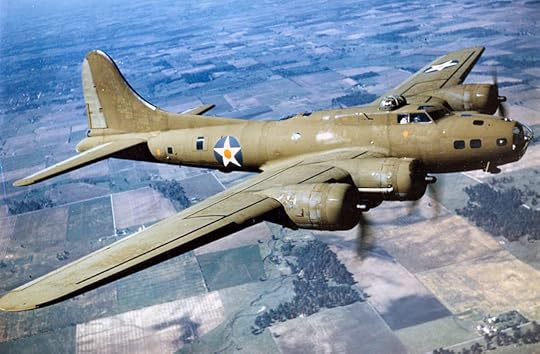
Boeing B-17E in flight, 1942. (U.S. Air Force photo)
Since no one expected dangerous head-on fighter attacks, the F model had weaker .30 caliber guns in the nose rather than the .50 caliber guns used in the rest of the plane. In addition, the nose guns could not be trained to twelve o’clock. The Luftwaffe quickly discovered this deficiency and adopted head-on attacks with devastating results to the Eighth Air Force. Desperation and ingenuity led airmen to shatter holes in the nose of the plane and suspend a .50 caliber gun with racks and retractable cords. Later B-17Fs incorporated a factory-installed .50 caliber nose gun and eventually a chin turret with two .50 caliber guns.
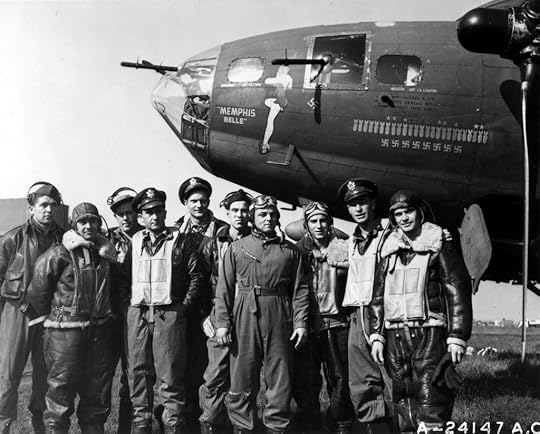
B-17 Memphis Belle and her crew, May 1943 (USAF Photo)
The last and most common model, the B-17G, entered combat in September 1943, but further refinements were made throughout the war.
Specifications
With a wing span of 103 feet and a length of 74 feet, the B-17G cut a graceful figure. Powered by four Wright R-1820 Cyclone engines, it could carry a crew of ten and a bomb load of up to 8000 pounds (but less on long-distance missions). The B-17G had a top speed of 302 mph and a ceiling of 36,400 feet. Depending on the model and theater of operations, B-17s carried ten to thirteen machine guns.
The B-17 was the first plane to use turbo-superchargers, which boosted engine performance at high altitude. The plane also featured the Norden bombsight, a complicated piece of machinery that allowed the bombardier to compensate for airspeed, wind speed, and drift when bombing. Purported to drop a bomb in a pickle-barrel, the Norden never reached that accuracy in combat, but did allow successful high-altitude, daylight strategic bombing.
February 29, 2020
Today in World War II History—February 29, 1940
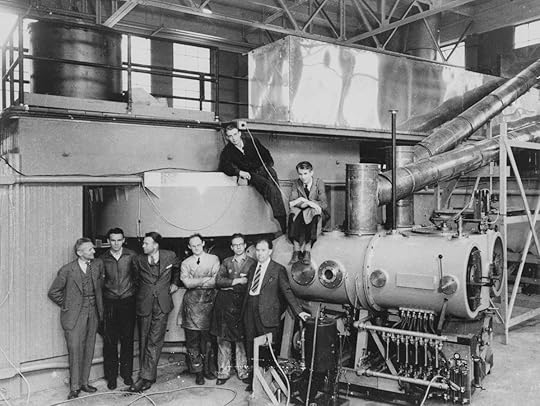
Cyclotron at the Lawrence Radiation Laboratory, Berkeley, CA in 1939; the key figures in its development and use are shown, left to right: Dr D Cooksey, Dr D Corson, Dr Ernest Lawrence, the inventor of the cyclotron; Dr R Thornton, Dr J Backus, WS Sainsbury, Dr LW Alvarez, and Dr Edwin Mattison McMillan (Science Museum London)
80 Years Ago—February 29, 1940: Nobel Prize in Physics awarded to Ernest Lawrence; ceremony held in Berkeley rather than Stockholm.
Academy Awards are held:
Best picture of 1939—Gone with the Wind
Best actor—Robert Donat in Goodbye, Mr. Chips
Best actress—Vivien Leigh in Gone with the Wind
Hattie McDaniel becomes the first black woman to win an Oscar (supporting actress in Gone with the Wind).
February 28, 2020
Today in World War II History—February 28, 1940 & 1945

Blenheim light bomber of the RAF being towed away by horses after landing on the frozen Jukajärvi lake, near Juva village, Finland, 25 Feb 1940 (public domain via WW2 Database)
80 Years Ago—February 28, 1940: First group of British volunteers arrive in Finland, under command of Lt. Kermit Roosevelt, son of former US president Theodore Roosevelt.
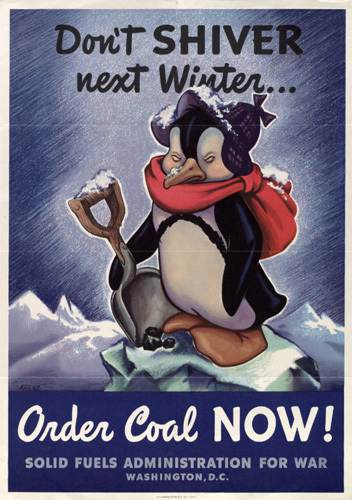
US poster, WWII
75 Years Ago—Feb. 28, 1945: US Eighth Army lands unopposed on Palawan in the Philippines and takes Puerto Princesa and its airfields.
In the US a midnight curfew is placed on nightclubs, sports arenas, theaters, and bars to conserve coal—restaurants and USO clubs are exempt if alcohol is not served.
February 25, 2020
Today in World War II History—February 25, 1940 & 1945
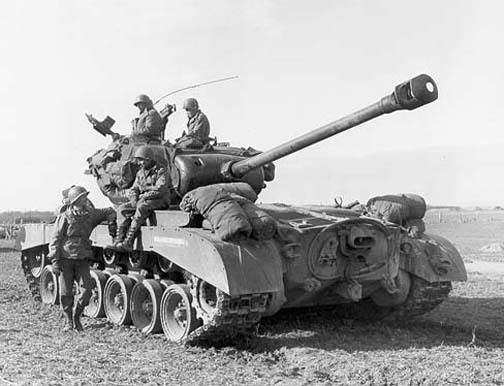
M26 Pershing heavy tank of US 9th Armored Division, near Vettweiss, Germany, Mar 1945 (US Army photo)
80 Years Ago—February 25, 1940: First Royal Canadian Air Force squadron arrives in Britain.
75 Years Ago—Feb. 25, 1945: US Fifth Fleet carrier aircraft and B-29 bombers strike Tokyo in a devastating raid.
US M26 Pershing tanks are first used in combat in Europe.
Turkey breaks neutrality and declares war on Germany and Japan.
February 24, 2020
Today in World War II History—February 24, 1940 & 1945
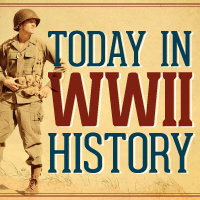 80 Years Ago—February 24, 1940: British Summer Time begins (daylight savings time moved up for wartime).
80 Years Ago—February 24, 1940: British Summer Time begins (daylight savings time moved up for wartime).
75 Years Ago—Feb. 24, 1945: Egyptian Prime Minister Ahmed Maher Pasha declares war on the Axis and is immediately assassinated in the parliament chamber.
Hitler makes his last speech in the Chancellery in Berlin.
February 19, 2020
A Girl’s Guide to the Outback, by Jessica Kate
 With her sharp mind for business, Kimberly Foster has big plans for Wildfire, the youth ministry where she works in Virginia. But she is constantly butting heads with the ministry’s founder, handsome Australian Samuel Payton. When Kimberly defies him and presents her expansion proposal, the board approves it – but Sam quits and heads home to the ailing family farm in Australia.
With her sharp mind for business, Kimberly Foster has big plans for Wildfire, the youth ministry where she works in Virginia. But she is constantly butting heads with the ministry’s founder, handsome Australian Samuel Payton. When Kimberly defies him and presents her expansion proposal, the board approves it – but Sam quits and heads home to the ailing family farm in Australia.
Without Sam and his big heart for kids, the ministry flounders. The board tells Kimberly to woo Sam back…or else.
Kimberly flies to Australia, where she meets Sam’s feisty sister Jules and gets drawn in to the Payton family. If Kimberly can use her business smarts to save the farm, Sam promises to return to America to select his own replacement. As they work together on the farm, Kimberly begins to see the vulnerability behind Sam’s maddening caution, and Sam begins to see the hurting heart behind Kimberly’s frustratingly blunt ways. But can their growing friendship and attraction survive the challenges they’re about to face?
Full of humor and snappy banter, A Girl’s Guide to the Outback is loaded with fish-out-of-water Australian fun. And yet Jessica Kate tells a far deeper story. Kimberly and Sam and Jules are each hurting in their own ways, each searching for identity, and each running from what they most need. These three compelling characters pulled me in to the story and had me finishing it in record time – despite a crazy-busy schedule on my end! Thoroughly enjoyable and highly recommended!



